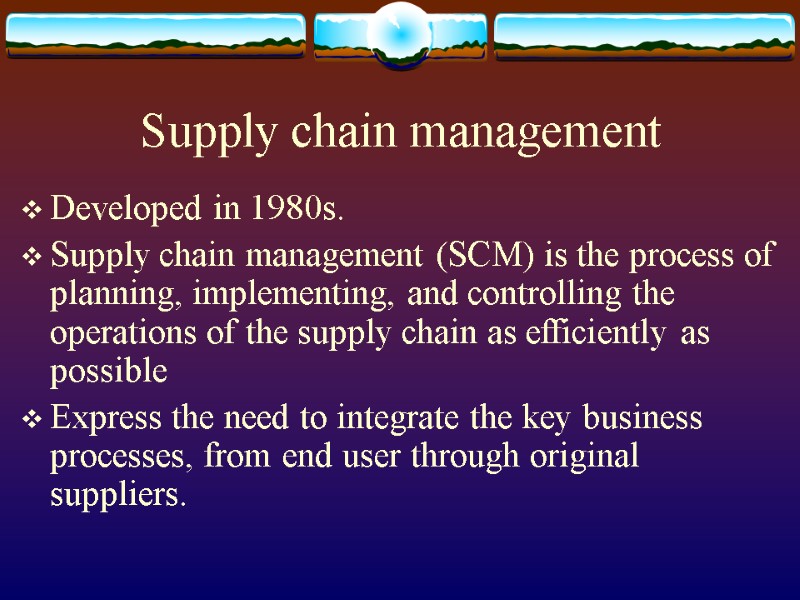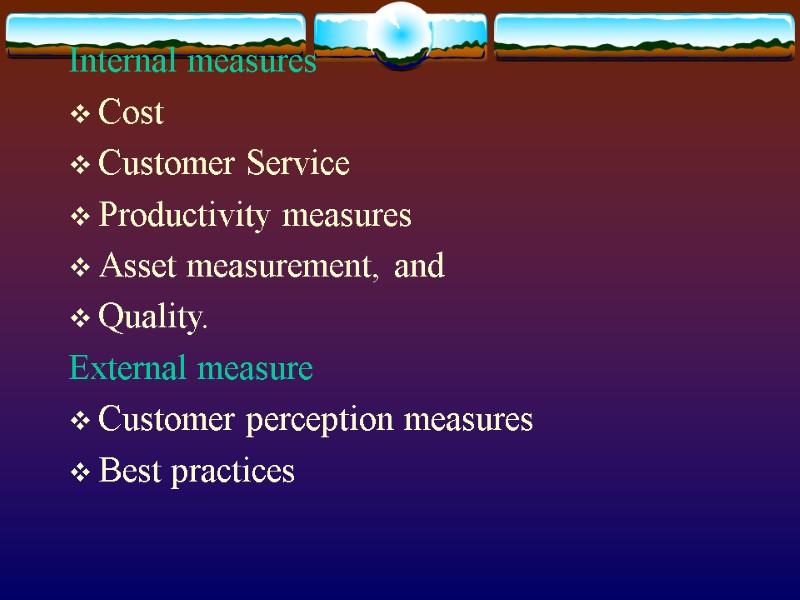Supply Chain Presented by [email protected] Contents: What is


Supply Chain Presented by [email protected]

Contents: What is supply chain Supply chain Management SCOR model SC Business process integration References

What is Supply Chain A supply chain is the system of organizations, people, activities, information and resources involved in moving a product or service from supplier to customer . Supply chain activities transform raw materials and components into a finished product that is delivered to the end customer.


Supply chain management Developed in 1980s. Supply chain management (SCM) is the process of planning, implementing, and controlling the operations of the supply chain as efficiently as possible Express the need to integrate the key business processes, from end user through original suppliers.

SCM The basic idea behind the SCM is that companies and corporations involve themselves in a supply chain by exchanging information regarding market fluctuations, production capabilities. The primary objective of supply chain management is to fulfill customer demands through the most efficient use of resources Effective Supply Chain Mgt. is the next logical step towards increased profits and market share

Supply-Chain Operations Reference (SCOR ) process reference model developed and endorsed by the Supply-Chain Council (SCC ) enables users to address, improve, and communicate supply chain management practices within and between all interested parties.

SCOR is based on five distinct management processes: Plan Source Make Deliver Return

Plan - balance aggregate demand and supply to develop a course of action which best meets sourcing, production, and delivery requirements. Source - procure goods and services to meet planned or actual demand. Make - transform product to a finished state to meet planned or actual demand. Deliver - Processes that provide finished goods and services to meet planned or actual demand, typically including order management, transportation management, and distribution management. Return - Processes associated with returning or receiving returned products for any reason.

Pillars of SCOR model The model is based on 3 major "pillars": Process Modeling Performance Measurements Best Practices

Process Modeling All customer interactions, from order entry through paid invoice. All product (physical material and service) transactions, from your supplier’s supplier to your customer’s customer, including equipment, supplies, spare parts, bulk product, software, etc. All market interactions, from the understanding of aggregate demand to the fulfillment of each order.

Performance Measurements Contains more than 150 key indicators that measure the performance of supply chain operations

Best Practices The SCOR model defines a best practice as a current, structured, proven and repeatable method for making a positive impact on desired operational results

Current - Must not be emerging Structured - Has clearly stated Goal, Scope, Process, and Procedure Proven - Success has been demonstrated in a working environment. Repeatable - The practice has been proven in multiple environments. Method- Used in a very broad sense to indicate: business process, practice, organizational strategy, enabling technology, business relationship, business model, as well as information or knowledge management. Positive impact on desired operational results - shows operational improvement related to the stated goal

SC Business process integration Successful SCM requires a change from managing individual functions to integrating activities into key supply chain processes Supply chain business process integration involves collaborative work between buyers and suppliers, joint product development, common systems and shared information.

Keys of critical supply chain business processes Customer service management Procurement Product development and commercialization Manufacturing flow management/support Physical distribution Outsourcing/partnerships Performance measurement

Customer service management process Customer Relationship Management concerns the relationship between the organization and its customers Successful organizations use following steps to build customer relationships: establish and maintain customer support determine mutually satisfying goals between organization and customers produce positive feelings in the organization and the customers

Procurement process Strategic plans are developed with suppliers to support the manufacturing flow management process and development of new products In firms where operations extend globally, sourcing should be managed on a global basis

Procurement process The desired outcome is a win-win relationship, where both parties benefit, and reduction times in the design cycle and product development are achieved

Product development and commercialization Here, customers and suppliers must be united into the product development process, thus to reduce time to market As product life cycles shorten, the appropriate products must be developed and successfully launched in ever shorter time-schedules to remain competitive

Physical distribution This concerns movement of a finished product/service to customers. In physical distribution, the customer is the final destination of a marketing channel, and the availability of the product/service is a vital part of each channel participant's marketing effort

Outsourcing/partnerships This is not just outsourcing the procurement of materials and components, but also outsourcing of services that traditionally have been provided in-house. The logic of this trend is that the company will increasingly focus on those activities in the value chain where it has a distinctive advantage and everything else it will outsource.

Performance measurement Experts found a strong relationship from the largest arcs of supplier and customer integration to market share and profitability. By taking advantage of supplier capabilities and emphasizing a long-term supply chain perspective in customer relationships can be both correlated with firm performance.

Internal measures Cost Customer Service Productivity measures Asset measurement, and Quality. External measure Customer perception measures Best practices

References en.wikipedia.org/wiki/Supply_chain http://www.mba.tuck.dartmouth.edu/pages/faculty/dave.pyke/case_studies/supply_chain_or_ms.pdf www.e-lberta/pdf/efc_supply_chain_basics.pdf www.supplychainseminars.com/ en.wikipedia.org/wiki/Supply_chain_management

9010-supply-chain-1207377920716168-9.ppt
- Количество слайдов: 26

